

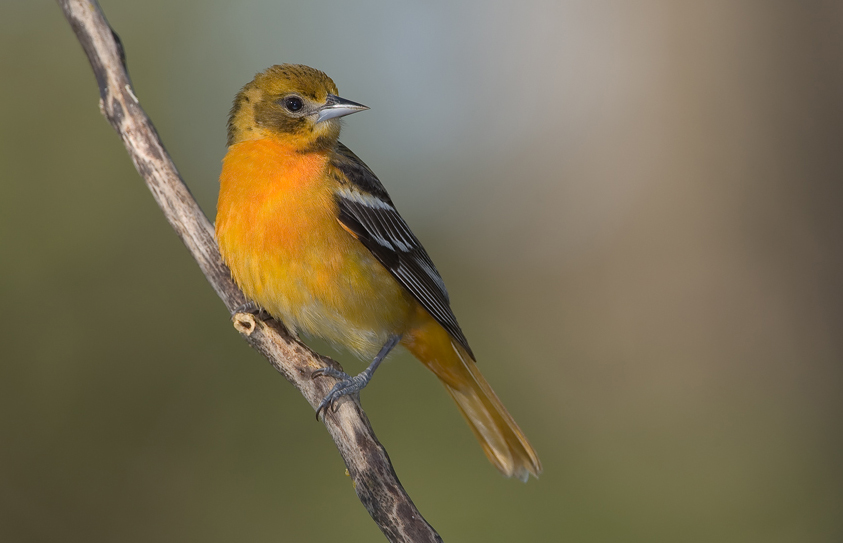
| Some things in life are
so good that they’re worth experiencing again and again. One of
those is the annual pilgrimmage to the warbler mecca known as Magee Marsh. Though I’ve
been to Magee many times, I never tire of it. Every winter I look
forward to the coming of spring, so that I can join my many friends
(both
human and avian) up in Ohio for two weeks of intense birding. And
every year when I make that trek I know that it’s going to be a unique
experience, because every year is entirely different. Every year
I get different photos, I meet different people, and I have
different—but always exquisite—interactions with some of nature’s
most beautiful creatures, the American wood warblers. Though every trip I’ve made to Magee has resulted in cherished memories of some sort or another, some years are definitely better than others. Variation in the weather and the timing of migration inevitably result in some degree of uncertainty every year as to the prospects for birding on any given day or week. Historically, the best time has always been the two weeks centered around May 15th, but in any given year the peak activity can occur earlier or later, and it’s impossible to predict much in advance (despite noble attempts by some prominent birders). This year I finally got the yellow
warbler photo I’ve been wanting: sharp,
well lit, with a good pose and a clean background. Though the yellows are common at Magee, they avoid people and are hard to photograph. (Click image for larger version) This year the warm winter and early spring conspired to allow the trees and bushes to leaf out about a month ealier than normal, prompting early insect hatches which in turn allowed the birds to feed at their leisure behind thick vegetation. This of course made photography difficult. Also, persistently detrimental wind patterns seem to have conspired to prevent large fallouts from occurring along the lakeshore. Anecdotal observations from banders indicated that many of the captured birds had zero percent body fat, which would be consistent with a pattern of slow northward progress against headwinds and only short stays at Magee. Secondhand reports by birders who’d been to Point Pelee (just across the lake from Magee) were also dismal this year. Nevertheless, this year’s trip offered some great moments and some great photo ops, as you’ll see from my daily blog from the field (see below). DAILY BLOG May 7, 2012 This morning Brandy and I loaded the car and hit the road for Magee. The trip from Durham (North Carolina) to Magee usually takes about 10 hours, give or take (depending on traffic). This year I made the mistake of following the GPS directions on my iPhone, which took me along the Columbus route that involves many slow roads with traffic lights (route 77 to the turnpike is better). (For first-time visitors to Magee Marsh, the web site mageemarsh.org includes lots of info for planning your trip, including interactive maps and directions.) 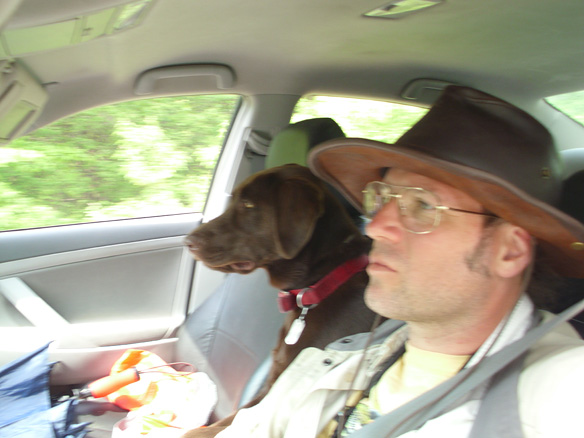 Brandy and I on our northward “migration” to Magee Marsh (Brandy's the
furry one... I'm the one wearing glasses). Like her predecessor Kelsey, Brandy has come to look forward to our Magee trips, primarily for the rare chance to swim in one of the biggest lakes in the U.S. This year I stayed in Toledo instead of Clyde. I had always liked the Red Roof Inn in Clyde (it’s new and very clean), but I found that the Red Roof in Toledo provides slightly quicker access to Magee (via route 2), and there’s a great Chinese restaurant next door that delivers to the hotel (though they sometimes forget to bring the extra carton of rice for Brandy...). Clyde had far fewer food choices, so I usually ended up eating at Subway every single night (my old dog Kelsey never complained: she loved their foot-long chicken sandwiches). Toledo has many more food options.  Brandy testing out the beds at the
Red Roof Inn. This was her
first trip to Magee Marsh, after taking over the job of her predecessor, Kelsey. Kelsey came to Magee with me every single year. She was 14 when she passed away last summer. Kelsey was popular among the regular birders at Magee, many of whom looked for her every year. They were very sad to hear that she was gone. May 8, 2012 This morning Brandy and I woke early and loaded the car for Magee. I spent last night meticulously cleaning my lenses and making sure all my batteries were charged. Flash units consume more battery power than you could possibly imagine. If you haven’t seen my photo of the “Squidmonster”, my preferred battery-charging solution, it’s worth re-posting here: 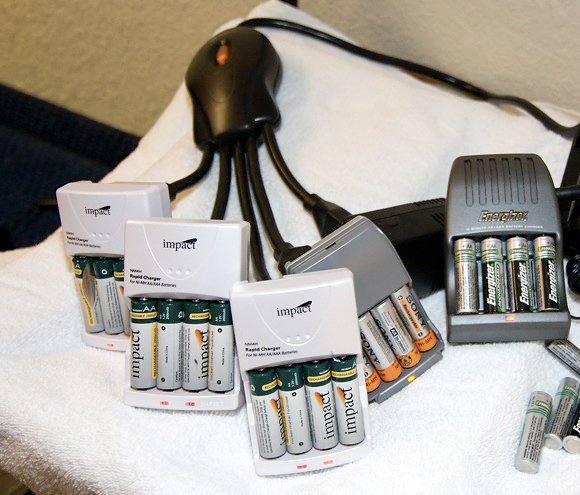 The squidmonster. It’s the best way to charge massive numbers of AA batteries for flash units, since it takes up only one power outlet. Note that I use only Energizer rechargeables now, due simply to their ready availability in places such as supermarkets. They do wear out and need to be replaced (as with all brands). You can read all about the Squidmonster and the use of flash for bird photography in my free, online manual, Secrets of Digital Bird Photography. When I pulled into the parking lot at Magee I witnessed the usual circus: hundreds of people swarming all over the parking lot and environs searching for birds. I set up my camera rig hastily—I always feel late to the party on the first day, wondering what I’d probably just missed. Birding the edge of the forest along the parking lot produced a handful of vireos, chestnut-sided warblers, and myrtle warblers. Though there were far more people than birds, it was exhiliarating to be back at Magee finally, and I felt the adrenaline coursing as I found myself getting back into the rhythm of the hunt. 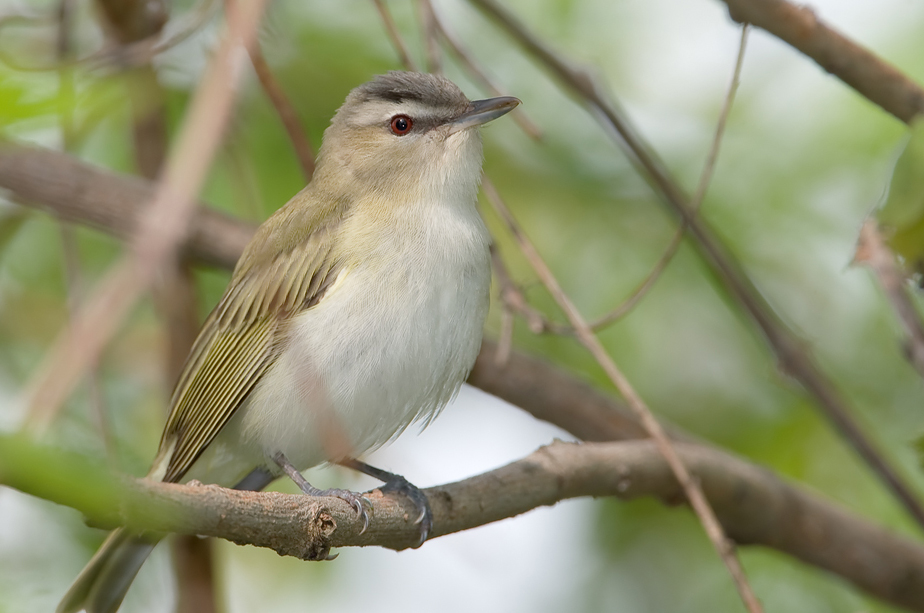 Red-eyed vireo at the edge of the
forest along the parking lot.
When the activity in the parking died down I decided to try out the new trail I’d heard they added for this spring, the “Crane Creek Estuary Trail” (which we just call the “West Trail” or the “New Trail”). This new trail begins just beyond the westernmost edge of the parking lot and extends westward along a berm separating Lake Erie from the Black Swamp. It’s actually a very nice trail, and is quite different in many ways from the other trails at Magee. 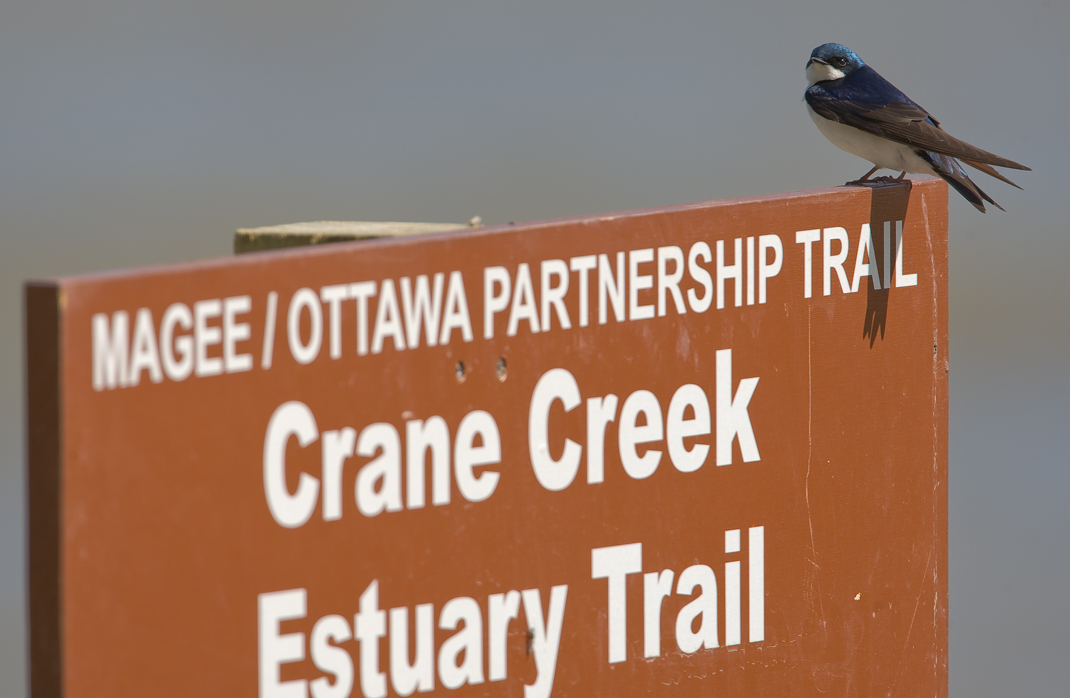 Sign for the new trail at the west end of Magee. It runs from the beach at the west end of the parking lot out toward Ottowa Wildlife Refuge (but does not connect with Ottowa’s trail system). The new trail is very wide and very open, and it seems to attract a different cohort of birds, as compared to the boardwalk. Its very newness is attractive of course, since nobody knows for sure yet what the new trail will end up being best for. The lighting situation is very different, since it admits more direct sunlight (an issue for bird photographers—and not necessarily a good one, since direct sunlight is much harder to control than flash). 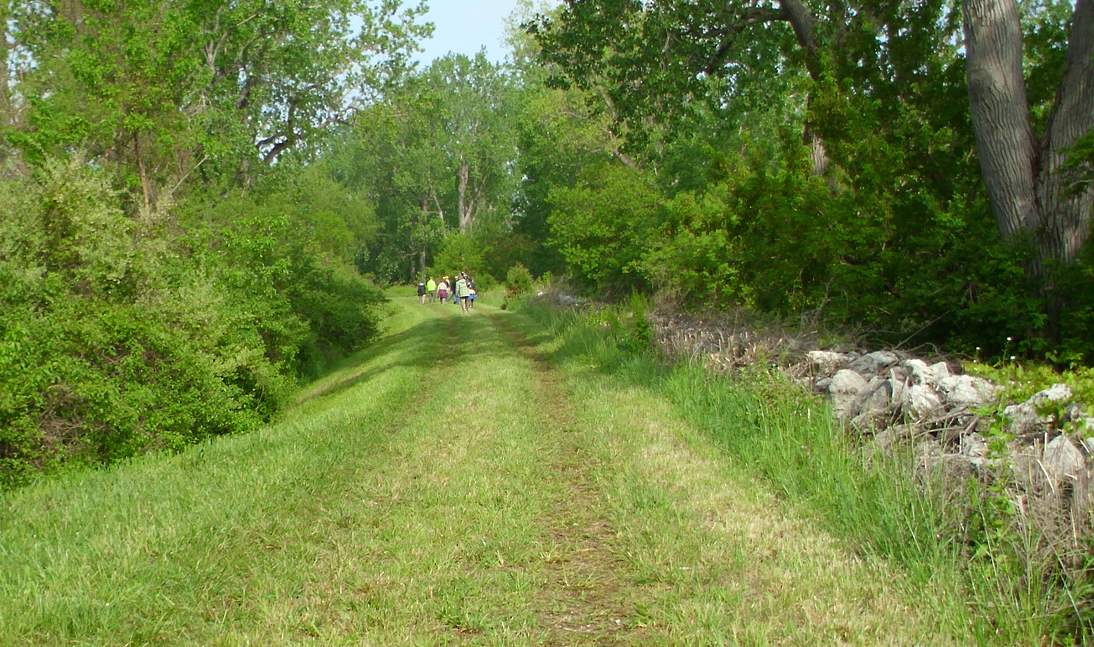 The “Crane Creek Estuary Trail”. We just call it the West Trail. It’s nice and open. I think it has a lot of potential, both in terms of the bird habitat, and how unlikely it is to get as crowded as the boardwalk. At the very beginning of the trail I got a photo that I knew would be a keeper: a veery showing off out in the open (but without direct sunlight, fortunately). The bird showed off for several minutes in front of a very half-decent background. I’d only been at Magee for twenty minutes and already I knew this was going to turn out to be a good trip. 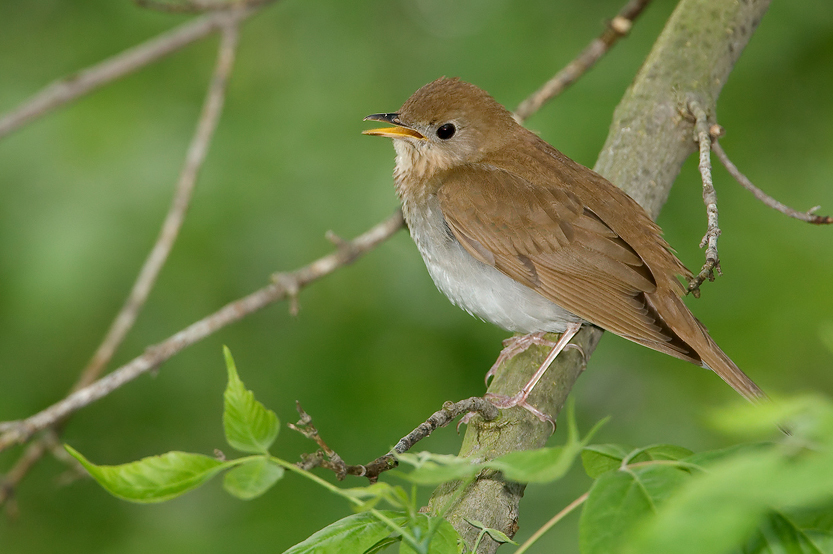 Veery on the new West Trail. I love thrushes: they lack the color of warblers but possess an understated beauty in their shades of brown and white. Capturing those subtle shades with the camera can be tricky. Flash helps enormously with the whites, bringing out what I call micro- contrast (you can read about this in my free, online book). One thing to note about the West Trail is that they actively band birds there on certain days. As you walk along the berm you can see little “hidden” trails going into the thicket, and if you peer down these you’ll see nets set up. When banding is actively going on the nets will be unrolled and you may see warblers struggling to get free of them (as in the image below), while on other days they’ll be rolled up so as not to ensare any birds when the banders are away.  Vireo caught in a net. The bander came by a minute after I shot this photo and put the bird in a little bag. These bags of birds then get carried to the banding station where the birds are banded and measured and then released. Though some people feel that the netting and banding process causes the birds considerable stress (as it certainly does), it’s necessary for the progress of science. After completing the West Trail for the very first time, I headed back out to the parking lot and then walked the boardwalk. Before long I had run into all of my old friends and had spent quite a lot of time (probably too much time) catching up and socializing. At noon I let Brandy swim in the biggest lake she’s ever seen: Lake Erie. She was not disappointed. She fetched what was probably the biggest stick she’s ever fetched. The image below shows her and her stick on the right; in the left pane you can see the lake shore, where shorebirds are very occasionally seen. Perhaps more importantly, you can sometimes see a Kirtland’s warbler out here. Though most of the warbler-watching takes place in the forest at the edge of the swamp, at least once a year I find myself doing some serious birding right on the Lake Erie shore. 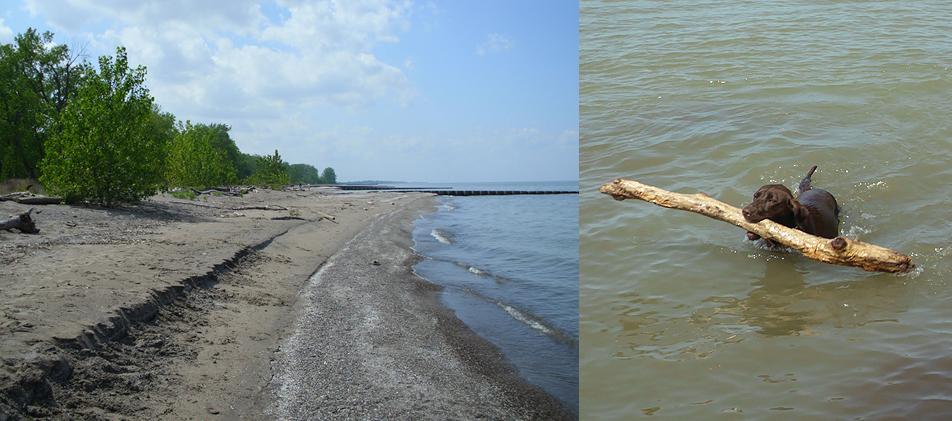 Left: the Lake Erie shoreline. You can sometimes see killdeers and other shorebirds here, but not much warbler watching occurs on the beach except when a Kirtland’s warbler shows up. Right: Brandy with a stick. Dogs are permitted in the park, just not on the boardwalk. There is a dog training beach here where dogs swim off-leash. Birds seen included ruby-crowned kinglets, yellow warblers (who breed here), chestnut-sided warblers, myrtle warblers, warbling vireos, and Northern parulas. On the south edge of the big loop we did find some fox snakes denning in a broken tree, which provided a different sort of entertainment:  Eastern fox snake in a broken
tree. When the birding gets slow,
photographers and birders find other things to occupy their attention until the next wave of birds arrives. Most birders wouldn’t go out actively looking for snakes, but with so many people wandering the boardwalk and so many eyeballs scanning the environs for birds, other types of animals are inevitably discovered here and there. For the more interesting ones, once word gets out, a crowd starts to form. I’m certain that hundreds of people saw this snake, and probably thousands of photos were taken of it.  Another shot of the fox snake. In late afternoon, a regular photographer at Magee named Larry discovered the nest of a “rare” bird called the “Orange Breasted Worm Eater” (also known as the American robin) on the west edge of the big loop; active bird nests are a great find a Magee, since they provide an intimate view into the reproductive lives of these birds. Every year a number of such nests are found (particularly owl nests) and subsequently seen by hundreds or even thousands of people.  Orange Breasted Worm Eater (also known as the American robin) sitting on a nest close to the boardwalk on the big loop. I was a bit chagrined to hear today that yesterday was the best day at Magee, this year, so far. If I’d only left a day earlier I would have seen it firsthand. (And as I’ll find out later, many photographers thought it was the best day this year). It’s always difficult to decide which days to schedule for my yearly trip to Magee. To minimize costs I try to keep my stay between a week and ten days, so I can’t be here for the whole season, and that means I have to choose the dates of my visit carefully.  It’s often difficult to get photos of warblers without leaves in the way, even at Magee, but this year it was particularly hard, since the leaves came out about a month earlier than usual. I tend to prefer the second and third weeks of May, though I’m increasingly starting to favor the second week over the third week. In the third week it usually starts to really leaf out (making photography difficult because of all the leaves the birds can hide behind). This year it leafed out about a month earlier than normal, causing a lot of frustration for the photographers. 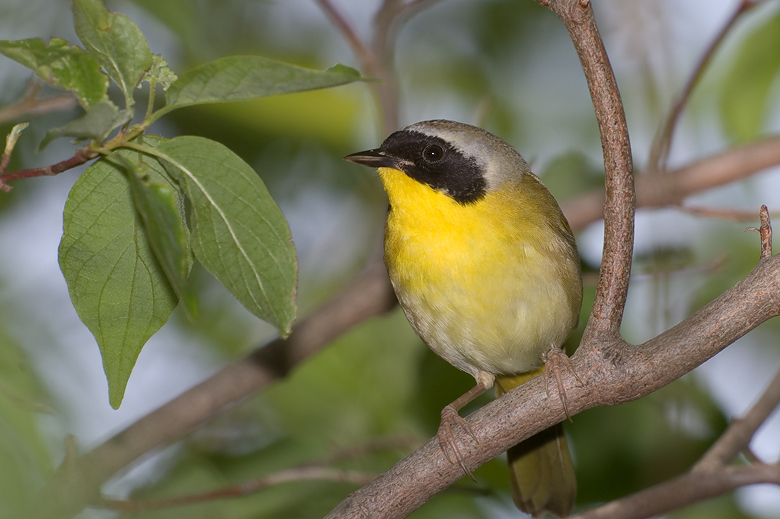 Common yellowthroat. These birds breed at Magee, and just like the yellow warblers they tend to be hard to photograph, because they’re wary of people. The non-resident birds who are just passing through are usually much more willing to let you get close. This particular bird was a rare exception. May 9, 2012 When I arrived at Magee this morning it was a bit quiet, so I decided to try the new trail again. The banders were at work, and I found several birds hanging in nets (including a very irate catbird). Otherwise, the birding was very light. I headed back to the parking lot and then put Brandy in the car for her nap so I could bird the boardwalk (dogs are permitted in the park, but not on the boardwalk). Though I saw a reasonable diversity of warbler species, the birds were mostly too high in the trees or too far in the bush for effective photography. I saw black-throated blues and greens, prothonotaries, magnolias, chestnuts, parulas, yellows, warbling vireos, palms, gnatcatchers, black-and-whites, kinglets, and a Canada warbler (always a treat). 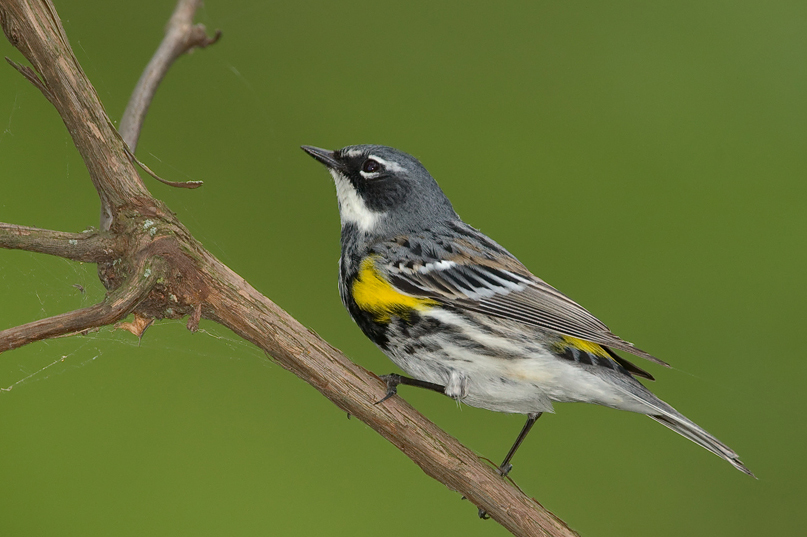 Yellow-rumped warbler at
Magee. Because these are so common in
my home state I usually ignore them at Magee, except on slow days, or when I find a really nice-looking individual in front of a good background. Though the crowds had been fairly thick this morning, at one point I suddenly noticed an absence of people. As I looked around, the only people I saw were hastily walking away from me, toward either of the two ends of the boardwalk. Just then I got a phone call: it was my friend George, telling me that our other friend Tom had found a Kirtland’s warbler on the boardwalk, but that it had quickly fled the boardwalk and flown toward the lake. People were now amassing around it in the overflow parking area. I generally avoid chasing rare birds at Magee, because I’ve found that it’s usually counterproductive to battle the huge crowds that form around the scene of a rare bird sighting. Such crowded situations usually make photography either difficult or impossible. However, I recalled the Kirtland’s warbler sighted here in 2010 and how I had initially resisted chasing it but had eventually relented and ended up getting truly phenomenal photos of it. So I headed out to the overflow parking area. You can see the initial crowd below, which ended up swelling to three or four times this size:  Kirtland’s warbler at Magee Marsh. The bird was at the tippy-top of a very tall tree, making photography utterly impossible. I instead switched to people-photography, to document the event. Unfortunately the bird was way too high to even contemplate photographing it, even with my 700mm rig (500mm f/4 lens with a 1.4x teleconverter). I decided to get out my tiny point-and-shoot camera to document the event. I recalled that in 2010, even though I got great shots of the Kirtland’s warbler, I didn’t bother photographing the enormous crowd that gathered. Later when I prepared my slides for several talks I was invited to give (to local Audubon chapters and such), I had to get special permission to use someone else’s photos of the crowd during my talk (photos that showed me in the midst of hundreds of other birdwatchers). Now I try to remember to always take my own crowd shots at major birding events, so that I don’t have to beg someone else to let me use theirs. 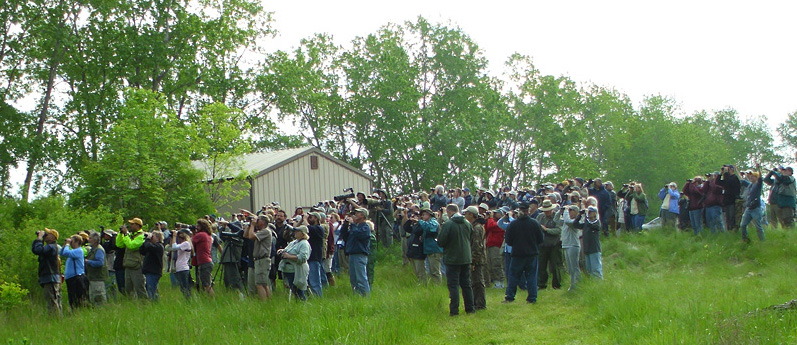 Another shot of the crowd at the Kirtland’s sighting in the overflow parking area. A friend who’d been present when the crowd started to form said that people literally ran from the boardwalk to the site... even people who normally walk with a cane... Later in the day another Kirtland’s would be reported (even tweeted on the official Magee twitter feed), but that turned out to be a Magnolia warbler. Similarly, a call by a birder of an ovenbird turned out to be a hermit thrush. Mis-identifications do happen. Personally, that doesn’t bother me like it does more “serious” birders. I love all birds, regardless of their race, color, religion, or political leanings. I don’t get too hung up over names. And many of the common ones look just as pretty to me as the rarer ones. I’m just glad to be seeing any of them. After the Kirtland’s sighting I returned to the boardwalk, but didn’t get many photos. The resident prothonotaries are good for slow days like this, since they’re always present and aren’t shy about posing for the camera: 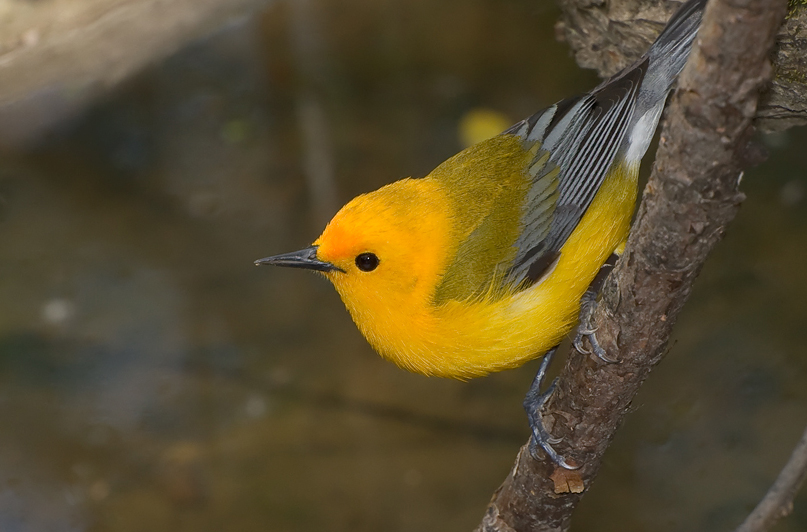 Prothonotary warbler foraging in the swamp. These birds nest here at Magee, and don’t care how close people get. They seem to ignore people entirely. They also don’t care about flash. I’ve seen them preen and pose for ten or fifteen minutes in front of a crowd of flash-wielding photographers. They simply don’t care about flash. Some birders dogmatically object to the use of flash, but the truth is that the birds themselves just don’t care. I was actually surprised to learn this fact. Returning to the parking lot, I ran into a friend who said he’d just birded the east beach and had seen some Wilson’s warblers, some palms, some yellows, and a magnolia or two. I decided to try that area, but didn’t see many birds close enough to photograph. I then tried the pedestrian road, where I saw some more yellow-rumps, a Philadelphia vireo, a Tennessee warbler, and a black-throated blue. But I wasn’t getting any photographs, and we were having intermittent storms, so I returned to my car to eat lunch with the pup. Once the rain abated the skies cleared a bit, and people came out of their cars. People coming off the boardwalk reported that it had only gotten worse for birding, so a bunch of us gathered at our friend Tom’s pickup truck. There we got out our lawn chairs and tripods and set up our cameras to try to get some oriole photos. Impaling a sliced orange on a tree branch usually brings them out.  Hanging out at Tom’s truck, waiting for the orioles to show up. We do a lot of socializing on slow days like this, and for me that’s one of the things I enjoy most about my trips to Magee: catching up with old friends. I’ve met some of my very best friends at Magee. Though we’d shot orioles many times over the years at Magee, we decided to be a bit more intentional about it this time. The first thing we did was to construct an “Orange Tree” by propping up dead branches and making sure the whole structure wasn’t too close to any other trees or bushes, so that the backgrounds would be rendered smooth and buttery by our large-aperture lenses. By providing a number of leafless branches for the orioles to perch on while they cautiously approached the orange, we helped to create some diversity in the photos we captured.  The “Orange Tree”. We propped some branches against each other and impaled a couple half-oranges on them to attract orioles. Note that the Orange Tree was placed some distance away from other trees. This improves the backgrounds of our photos, because the shallow depth- of-field of large apertures renders distant objects as nice, smooth gradients. It may not look impressive here, but just check out the photos we got... An example of a photo captured this
way (at the “Orange Tree”) is shown below. Note that
the
background is nice and smooth, and free of distractions. The
photo is so simple that it forces the viewer to focus their attention
on the bird. Note also that there is no fruit in the image.
Though we used oranges to attract the birds to within photographing
distance, we didn’t want to photograph the birds actually eating the
oranges, since those types of photos end up looking artificial.
Hence the importance of providing not only food for the
birds, but also perches that were close to the food but
not so close that the food would appear in the photo.
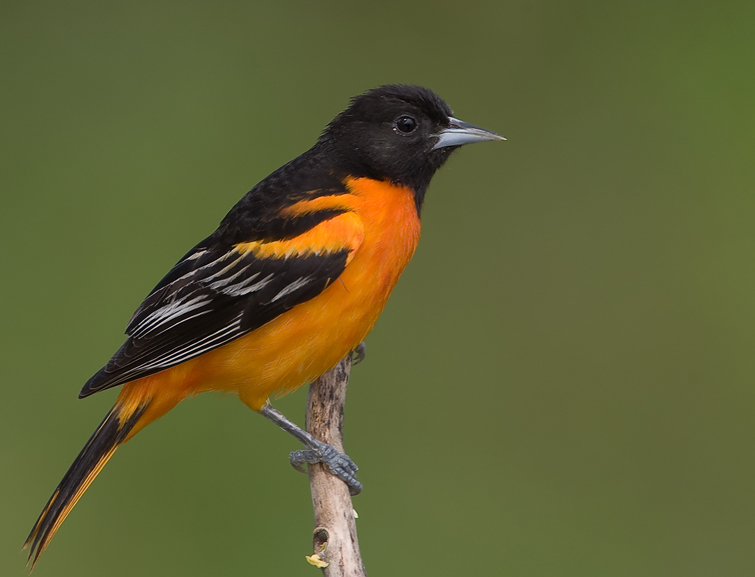 Oriole photographed at the “Orange Tree”. Note how the background is smooth (because large-aperture lenses blur distant objects). Note also that the use of strong flash has ensured that all parts of the bird are highly detailed (i.e., the underside of the bird is not overly shadowy). Shooting in groups like this also
provides an opportunity to gather information. I learned that the
overall numbers of birds that people were seeing seemed to be
relatively poor, compared to years past. Those who live locally
said that no single day
had yet stood out as being great so far, and that the wind patterns had
not been beneficial (northwest winds were pushing birds to the
south). In terms of particular species, I learned that Cape May
warblers had been notably absent so far, that a Prairie warbler (my
personal favorite) had been reported earlier in the season (a rarity
for this locale), and that hooded warblers had been reported several
times.
 Tree swallow on the “Orange Tree”. Though we’d set up the Orange Tree specifically to photograph orioles, this swallow was a welcome customer. In mid-to-late afternoon it began to rain again. Photographers at Magee (and elsewhere) have come to acknowledge that rainy days are common enough in May that it’s foolish to just put the camera away every time a few rain drops fall. Pro camera rigs can handle light rain just fine (note that this is not true of most consumer-grade cameras and lenses) due to their weather sealing, so by setting up our umbrella mounts we were able to continue shooting. You can see a few stray trails of raindrops in the image below, which I think gives this photo some added character: 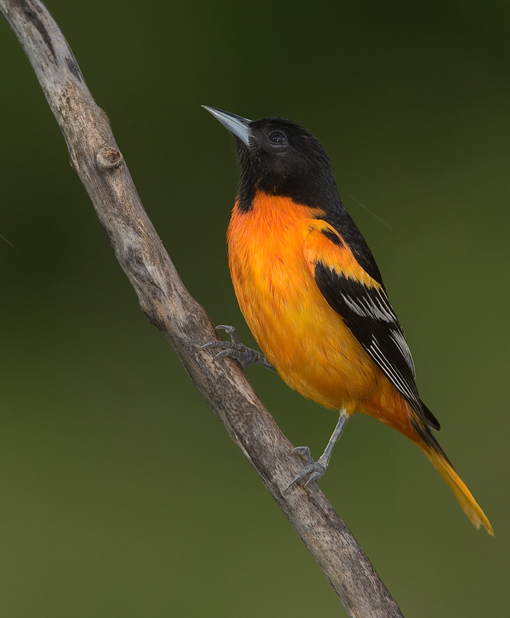 Oriole in the rain. Professional camera rigs can handle rain just fine (this is not always true of consumer-grade equipment), and shooting in the rain can give bird photos a unique character. Notice how this bird’s plumage is obviously wet. The birds don’t go inside when it rains, so why should we?! 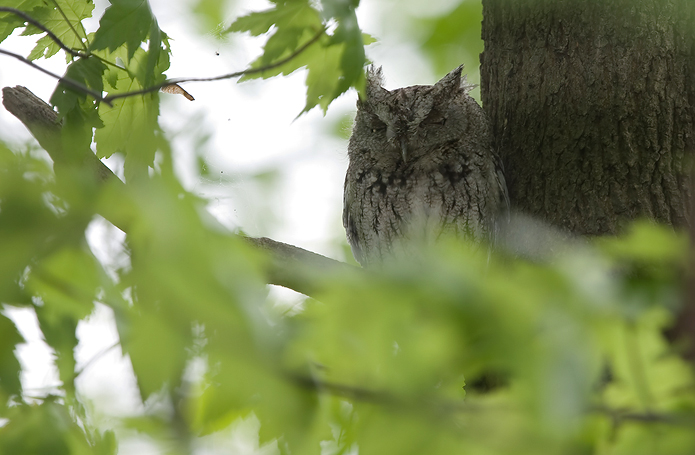 Screech owl napping at Magee. These birds nest here, and every year a nest is found and hundreds of people get to see these elusive birds—though usually it means peering through dense foliage. May 10, 2012 This morning when I arrived at Magee I found myself swatting at bugs—midges to be precise. Before long I realized that it wasn’t just me: everybody was swatting, slapping, and cursing at bugs. By mid-morning you could see that whole cars were covered with them, particularly those along the edges of the parking lot near the high grasses. If you walked through those grasses you stirred up huge clouds of bugs that choked your vision. This continued all day, and later we noticed that we could hear a persistent buzzing at all times that sometimes swelled to a loud crescendo. Apparently the rains and the unusually warm weather had precipitated a massive hatching of midge eggs that normally wouldn’t have emerged for another month. This is something I had never before witnessed at Magee, because my visits had always been limited to mid-May, and this is apparently a common occurrence in June. The locals call them muffleheads (family Chironomidae). The birds don’t call them anything, but they do like to eat them. In fact, though I ended up seeing relatively few birds today, many of those I did see were engaged in chasing and eating these bugs. The prothonotary warblers seemed particularly fond of them. Some birds actually had midges crawling up their legs and on their feathers, as if they wanted to get eaten. 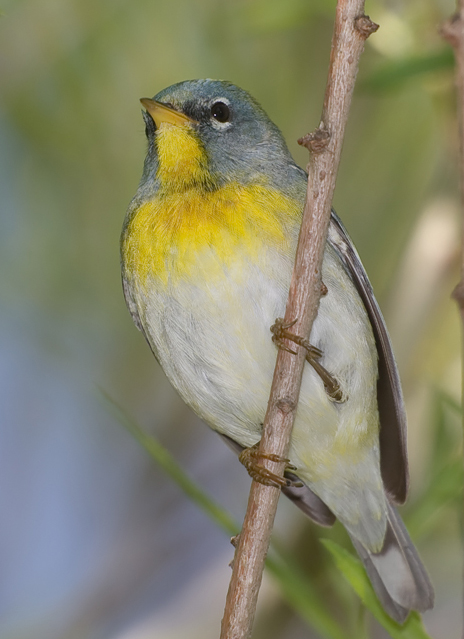 Northern Parula at Magee. This is one of the few birds I saw today that wasn’t gorging itself on midges. (But maybe it did so when my back was turned?). I spent considerable time on the boardwalk in the morning hours, walking from end to end and back again several times. Not only were the crowds much thinner today, but the birds seemed rarer as well (though they hadn’t seemed particularly thick yesterday either). As someone who birds by ear, I could say that there were definitely many more birds present than I was actually seeing. They just weren’t coming out into the open areas of low foliage where we could get a look at them. Many were high in the trees. I noticed many birders walking briskly along the boardwalk, as if searching for something to look at. I started thinking about the midges and figured that the birds were probably all gorging themselves on them. Suddenly within the space of a day there had become a superabundance of food available to these starving migrants, and it doesn’t take a huge stretch of the imagination to guess that the reason we weren’t seeing many birds on the boardwalk was that the birds were all sitting comfortably behind their defensive walls of leaves, eating bugs at their leasure (or that many had fulfilled their immediate calorie requirements and resumed their migration). Remember that the very reason that Magee Marsh is good for birding is that the birds, when they reach Lake Erie from the south, start to frantically gather calories to replenish their energy reserves in preparation for their flight across the lake. They end up caring less about avoiding people than about finding something to eat. So we get to see birds that normally (when well fed) avoid us. But on a day like today, with all this food available to them, they can again afford to avoid getting too close to humans. One notable discovery today was of a chickadee nest on the eastern edge of the big loop of the boardwalk: 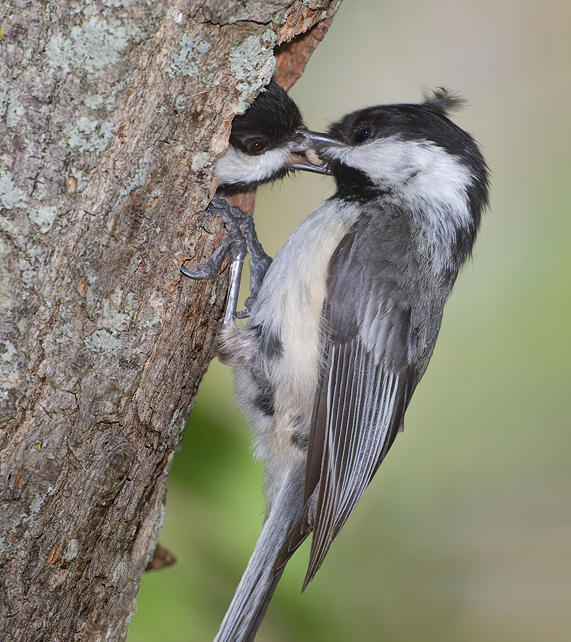 Chickadees exchanging food at a nest. This nest was located, quite literally, inches from where people were walking on the boardwalk at Magee (east edge of the big loop). The birds simply did not care that people were walking by, and they certainly didn’t care about some photographers pointing big lenses at them (with or without flash). The female stayed in the nest most of the time (coming out only once to beg animatedly for food from the male) while the male made repeated visits every four or five minutes. This nest was, quite literally, inches from where people were walking on the boardwalk. It was amusing to see how the birds often ignored people walking by, and how many people were oblivious to the birds. The photo below illustrates this: 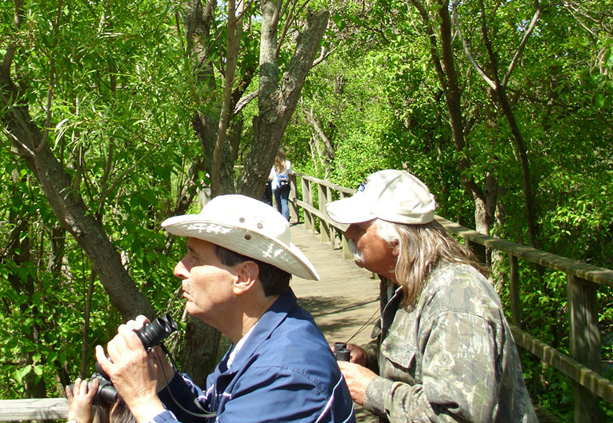 The chickadee nest was located just above the left gentleman’s hat (the cavity entrance is not visible here, but pointed toward the right). The nest was directly above the head of the gentleman on the left; neither fellow noticed the birds flitting in and out of the nest, since they were concentrating on finding warblers off to the west of the trail. Very few people actually seemed to noticed the chickadees, except when they were pointed out by those already watching them. Other birds that I saw (but in most cases couldn’t get a good photo of) included Northern parulas, magnolia warblers, ruby-crowned kinglets, blackbirds, and tree swallows. 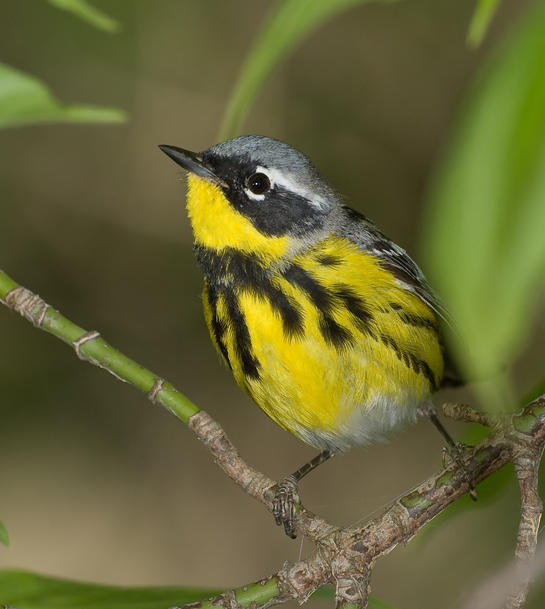 Magnolia warbler on the boardwalk. This is one of my favorite species, because I love their yellow ventral plumage with the strong black streaks. Like almost all my photos from Magee this year, this one is marred by some obscuring foliage. I was just happy to see one of my favorite birds, at close range, in one of my favorite birding places. By mid-afternoon I started to feel very lethargic. Though it was only my third day at Magee this season, I always put in long days here—usually 12 hours or more—and most of those hours are spent hauling around heavy (and expensive) camera equipment. For someone like me who normally sits at a desk all day, field work can become physically challenging. What keeps me going is the motivation I get when I see lots of birds and find that I’m capturing lots of great images. On slow days, that becomes tough. Fortunately, at Magee you can usually find something to shoot, even if it’s just a common bird that you could easily find back home. For me, since I don’t care too much about the rarity of the birds I photograph, that works just fine. 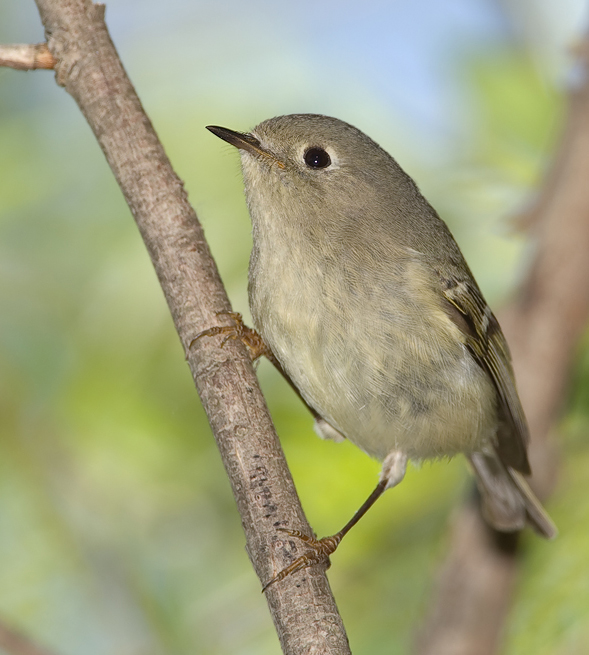 Ruby-crowned kinglet at Magee. Though I see many of these birds back home in North Carolina in winter, on a slow day at Magee I’m happy to shoot them if I can get a good pose and a decent background. One “special” bird did make an appearance today: a male rose-breasted grosbeak, along the forest lining the easternmost end of the parking lot. I was only able to get a very poor shot of the bird singing, with some motion blur and foliage in the way, but I guess it was better than nothing: 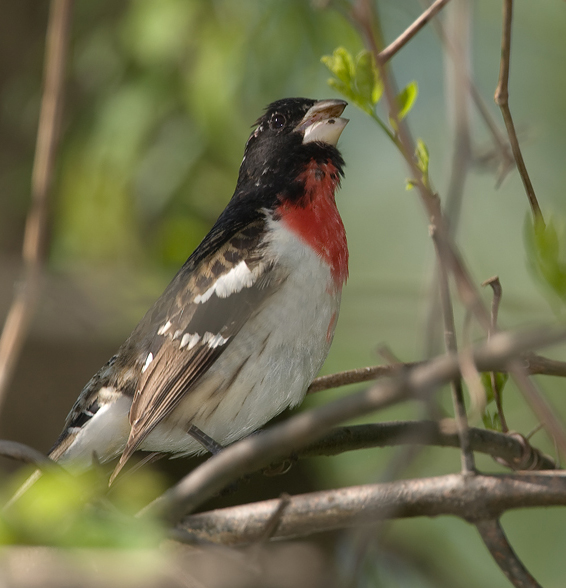 Rose-breasted grosbeak. Technically, this photo is terrible: it shows motion blur and therefore lacks sharpness, and there are multiple obscuring elements (a leaf at lower left and a horizontal branch passing through the middle), but it’s the only photo I have of this species and it documents a birding encounter that was exciting for me. Actually, another unusual bird did make an appearance today. This morning I had noticed a (nearly) adult bald eagle circling extremely low over the parking lot. In mid afternoon, while birding on the boardwalk I again glimpsed this bird from a distance as it circled over the parking area and then perched high in a tree near the small pond at the center of the boardwalk. I only had my 500mm lens with me, which was too weak for a highly detailed shot of the bird. Here’s a 100% crop image, which shows remarkably good detail, given the zoom level:  Bald eagle at Magee. Eagles do sometimes show up at Magee, and in fact the southern coast of Lake Erie is a great place to see this species. They nest in a number of locations, some of which can be great for photography. May 11, 2012 Last night at the hotel, while munching on Chinese food from the restaurant next door, I looked at the calendar and realized that “the big day”—meaning International Migratory Bird Day—was the day after tomorrow. That meant only one more day before the insane crowds of IMBD. This morning when I drove into the park I realized that the crowds could get insane even before IMBD arrived. It took considerably longer to navigate the long access road to the parking area, and upon reaching the parking lot I realized that Brandy and I should have skipped our traditional MacDonalds breakfast in order to claim a better parking space. There were, quite literally, tons of people present today. The parking lot was packed, and people were swarming all over the West entrance to the boardwalk. Unfortunately, there didn’t seem to be many birds. 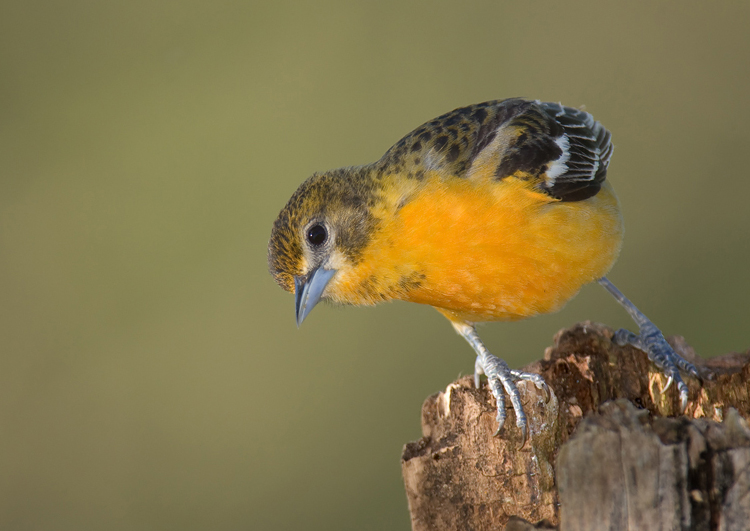 Days with low warbler activity, by default, become “oriole days”. The orioles are always present, and they’re very nice-looking birds. This year I got very few warbler photos worth keeping, but I got my very best oriole photos ever. I tried unsuccessfully to osmote myself into the crowd at the west entrance to the boardwalk, but quickly changed my mind and decided to try the east entrance. This is a common mistake: for some reason, most people seem to assume that all the action happens on the west end of the boardwalk. The west entrance thus gets clogged on high turnout days, while the east entrance remains underutilized, though on many days you can see as many birds at the east end as at the west end. The habitats are certainly different between east and west ends, but if your goal is to reach the boardwalk’s middle, then the east end is better because there are fewer people in your way. (This is my secret strategy. So please don’t tell anyone.)  Black-throated green warbler on the boardwalk. I saw very little on the boardwalk besides people, and the few birds I did see were too high, too far, or too obscured by leaves for quality photography. The black-throated green warbler above is one of the few decent shots I got of a warbler without leaves covering part of the bird. Other sightings included chestnut-sideds, blackpolls, prothonotaries, Canadas, and catbirds. 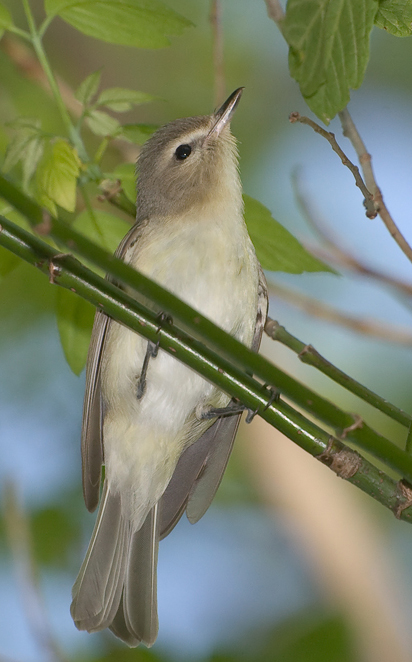 Warbling vireo. Not a great photo. In the vireo photo above you can see that there’s a second branch passing in front of the bird, and the photo itself is what I would call a “belly shot”, since it primarily shows the bird’s underside. Belly shots can sometimes look nice, but most photographers try to avoid them. On days when the birds are all high in the trees you’ll find that all you get are belly shots, and that gets monotonous after a while.  Mediocre shot of a Canada warbler. Apart from presenting a bad head angle, the image suffers from low resolution (the bird was simply too far away and I had to crop aggressively to blow up the bird). I normally throw photos like this away, but it’s the only Canada I got this year. At one point I ran into someone who had been talking to the banders, and he had some observations on the state of this year’s birding at Magee. Although those visiting for the virst time always think the birding is great (even when it’s poor), those who’ve been here many times have a baseline to compare to, and this year simply isn’t stacking up, compared to previous years. The bander said this year’s captures have been weighing in with zero fat reserves, meaning that none of the captured birds are ready to continue their migration. That suggests that the birds aren’t simply skipping Magee and continuing on. It’s likely that they’ve been fighting headwinds constantly during their northward trek, with no break in the winds to allow a large accumulation or fallout like we’re used to seeing several times each season. Also, with the leaves fully out there are many insects feeding on those leaves and the birds don’t need to search as hard to find food, so they’re not coming out into the open where we can see them. Anecdotal reports from Point Pelee and High Island indicate that these apparently were also poor this year (I would later hear that the banders were only finding half as many birds as in a normal year). 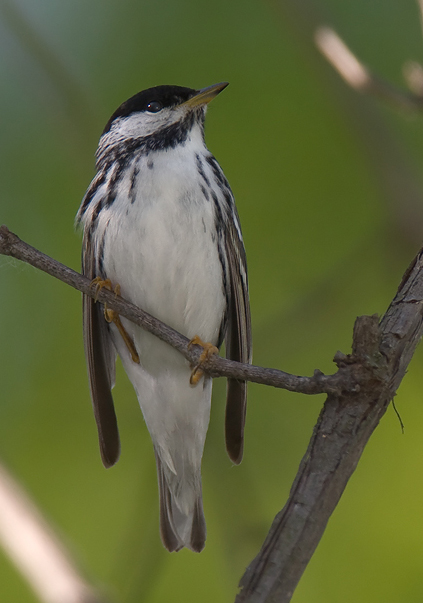 Blackpoll warbler. This is not a good photo either, but it’s been slim pickings this year (for photography). In terms of the quality of birding this year, keep in mind that the perception is often very different between bird watchers and bird photographers. Bird watchers are often satisfied to see a bird at a distance, at any angle, in any light, and any activity level. Photographers aren’t satisfied unless the bird is close, is well lit, has a good background behind it and no foliage in front of it, and if the bird is still enough to get a sharp image with no motion blur. Warbler photography is extremely difficult, and if the conditions aren’t just right, it becomes nearly impossible to get extremely high-quality photos. For those of us who’ve been doing this for a while, only the highest quality photos interest us. So it gets frustrating when the photo opportunities are less than ideal, especially when we’ve been spoiled by so many excellent years here in the past. Inside the small loop of the boardwalk, someone found a very nice-looking Cecropia moth:  Cecropia moth. One thing I have noticed this year—as with other years in the past here—is that individual birds seem to be hanging out all day in the same areas, because on subsequent trips around the boardwalk I’ll see the same species of bird in the same area and even sometimes in the same tree. In previous years I’ve even seen the same bird (presumably the same individual) in the same tree day after day. Today I repeatedly saw a blackpoll warbler by the west entrance to the boardwalk, and a blackburnian warbler close to the tower. By the afternoon we were all tired of fighting the crowds to get very marginal photographs, so we again hung out behind Tom’s truck, shooting orioles at the Orange Tree: 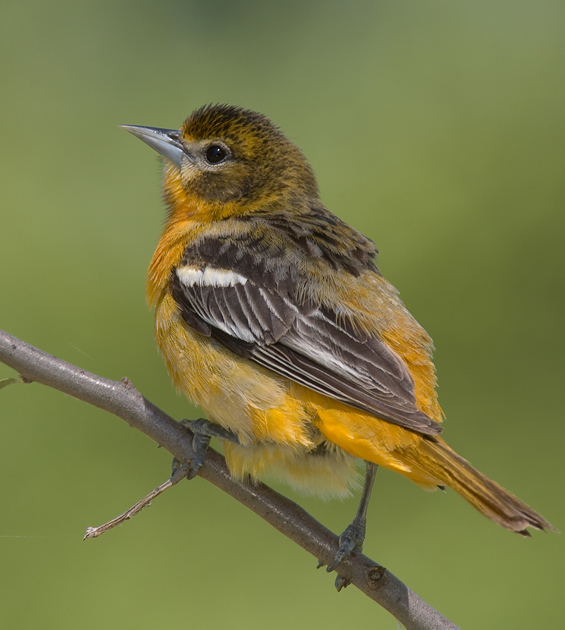 Baltimore oriole on a live branch near the Orange Tree. After a while, shots of orioles on the branches of the Orange Tree started to all look the same, so we scoured the lakeshore for interesting driftwood to prop up against it. We found a nice tree stump with a semi-hollowed inner pocket where we could put oranges out of view of the camera. The birds then perched on the top of the stump and also clung to the sides, providing some novel poses: 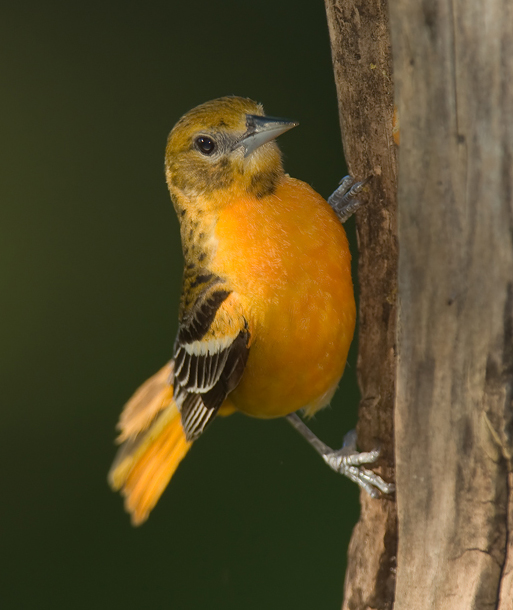 Oriole on the “Orange Stump”. Today I met quite a number of people who recognized me from my web site and thanked me for my free online instructional manual, Secrets of Digital Bird Photography, as well as the contributions I’ve made to mageemarsh.org. I didn’t realize how many people visit those web sites (or that people would recognize me in the field!). Several people told me they came to Magee specifically because of the web site. It’s very gratifying to be able to help people in this way. May 12 - INTERNATIONAL MIGRATORY BIRD DAY The biggest day at Magee is International Migratory Bird Day (IMBD), when many thousands of people show up, as well as vendors and tour guides. School children are bussed in. Banding demonstrations and book signings and guided bird walks take place. It can be extremely difficult to move around, especially on the boardwalk. But it can also be a lot of fun.  International Migratory Bird Day at Magee Marsh. Vendors sell signed copies of books or advertize their guided tours, while banders give banding demonstrations. (Photos from a previous year). This year there were, without a doubt, far more people than birds, and those birds largely remained high in the trees throughout the day. I always start IMBD out in the lawn next to the platform, where the Big Sit takes place. The Big Sit consists of a guy sitting on a ladder calling out all the birds he identifies, while his assistant writes them down and tabulates the numbers seen. Many other people gather round and help out by calling out any species the Big Sitter misses. It’s a good way to start the day, to see what birds are around and to get a sense for how the birds are moving—i.e., are they moving out of the forest toward the lake, or are they staying out of view in the woods, or in the swamp beyond the woods, etc. 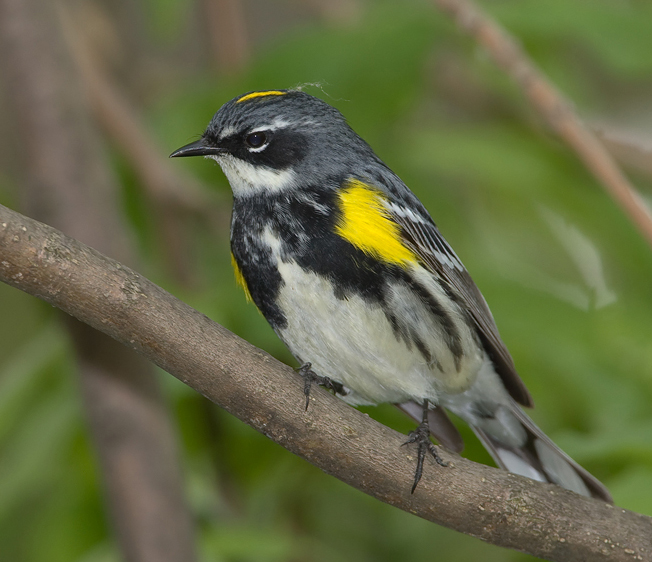 Yellow-rumped warbler along the forest edge. Winds did get strong out of the south for a while, pushing the birds toward the northern edge of the forest (where I was), but that didn’t last very long, and even while it lasted I didn’t get many decent photos. Around 10am I joined an excellent local birder and painter named Darin on the East beach, which can sometimes be very productive (with the added benefit that there are almost no people there most of the time—except when a Kirtland’s warbler is reported there). Though we could hear birds back in the thicket, none came out for a photo. We did, however, run into Ken Kauffman and Greg Miller—the famous bird watcher on whom the movie The Big Year is based. My only decent photos were of terns hunting over the lake: 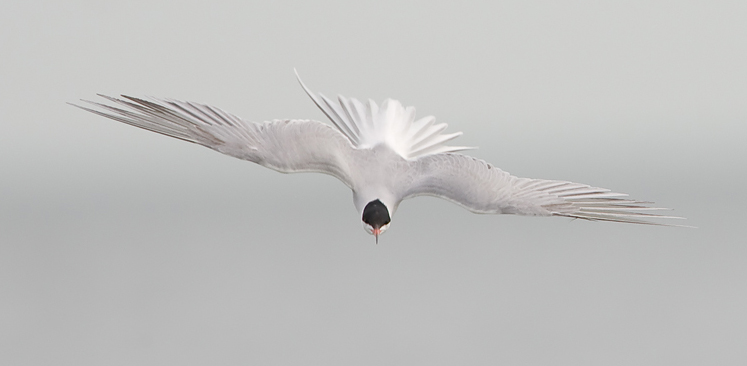 Tern hunting over Lake Erie. Returning from the beach I ran into a longtime Magee photographer named Larry, who reported that the West Tower had been excellent all morning. I decided to try it. It ended up being mediocre for a while, but after an hour or so the birds started staying too far from the tower and all the photographers left, including me. That was in early afternoon.  The “West Tower” at Magee Marsh (photos from a previous year). I decided to head back to Tom’s truck to see what the other guys were up to. They cooked some burgers on Tom’s grill and then we shot orioles at the Orange Tree for a while, till that started to get boring. Somebody checked their email and found that a Kirtland’s warbler had been reported on the new West Trail (the “Estuary Trail”) in the early afternoon. I headed out there and joined the large crowd surrounding the bird, but the bird stayed back in the thicket and I couldn’t get a clear view for an aesthetic photo. Putting Brandy back in the car for her afternoon nap, I did the boardwalk again, but had absolutely no luck whatsoever. Back at Tom’s truck they were having some luck with the orioles, so I joined them for a while and got a few more decent shots of birds on the tree stump: 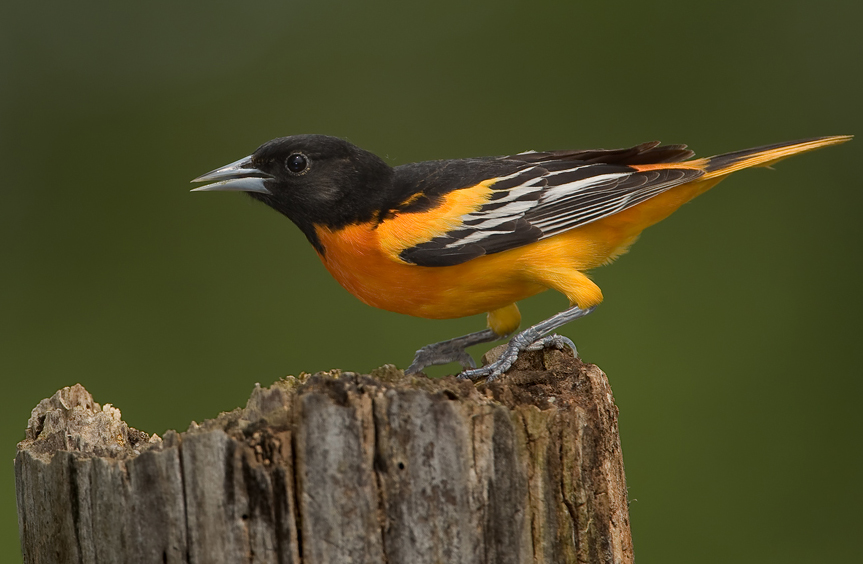 Baltimore oriole on a tree stump set up at the Orange Tree. So far today, the list of warblers I’d seen included prothonotary, Tennessee, yellow, parula, black-throated green, blackpoll, chestnut, yellow-rumped, Kirtland’s, and chestnut-sided. Other birds I’d seen included white pelicans (at the end of the new West Trail), blackbirds, great egrets, great blue herons, several species of terns, black-crowned night herons, purple martins, tree swallows, and catbirds (as well as orioles). Someone in our group reported that people have been seeing mourning warblers and golden-wings on the boardwalk these past two days, though they’ve been staying far back from the boardwalk, in the dense thicket. Also, whip-poor-wills have been reported. Around 5pm we got word that the Kirtland’s warbler was still being seen on the West Trail, so we decided to pack up and head over there as a group. The crowd had thinned to ten or fifteen people, so we were better able to move around with our big lenses to try to get a good angle on the bird. 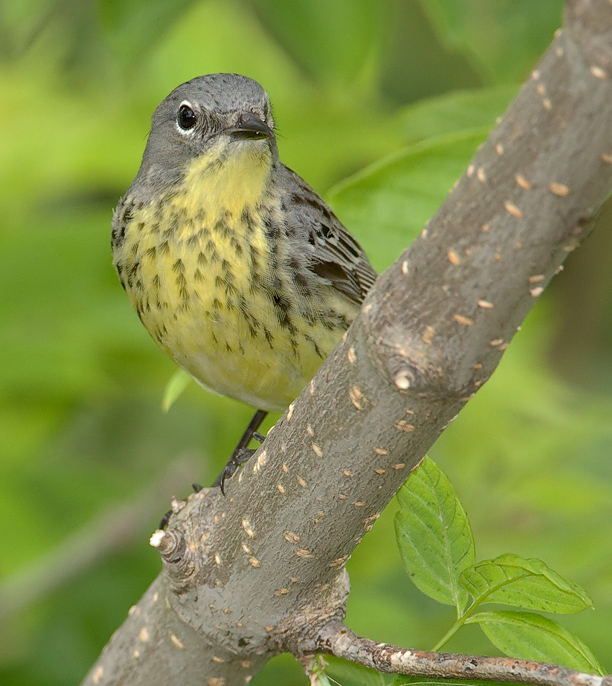 Kirtland’s warbler on the new West Trail (the “Estuary Trail”). The plumage is a little lighter than the one I shot at Magee in 2010. Someone in the crowd suggested that the bird looked like a female or young male. Compared to the Kirtland’s I shot in 2010, this bird seems to have less black in its plumage, particularly on the face and on the breast. One thing that always struck me about this species is the lightness of the yellow on the breast—it’s a very different hue from the yellows on many of the other warblers in the Eastern U.S., such as the magnolia warbler. 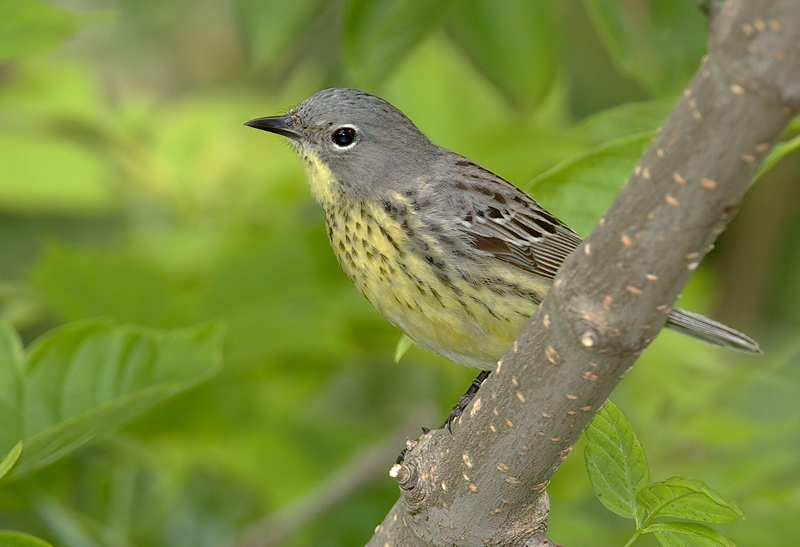 The Kirtland’s in another pose. Though the bird hung around for most of the day, all my good shots were taken within the space of a few minutes, when the bird came out of the thicket, after the crowd thinned. Though we’d had trouble shooting this bird earlier in the day, due to the crowds and due to its staying back among the thick foliage, we were now having much better luck. The bird was now coming out into the open for us. We were even using flash, but the bird didn’t seem to care at all. I always try to assess a subject’s reaction to the flash—especially in the case of an endangered or threatened bird like the Kirtland’s. This individual didn’t seem to care about the flash whatsoever. 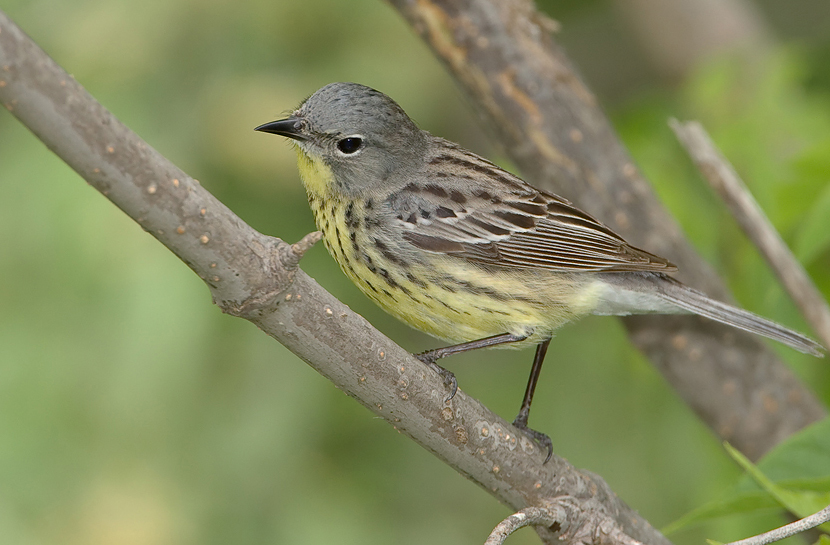 Another shot of the Kirtland’s. I don’t like the backgrounds in any of these shots of this bird, but this one is a little blurrier than the others (blurry backgrounds are generally better). One thing you will note about these photos is that the backgrounds are not buttery smooth: they’ve got some distracting background patterns, due to the foliage behind the bird being too close to be blurred by my large-aperture lens. Normally a large-aperture lens (like my f/4 lenses) will isolate the subject by blurring the background into a smooth gradient, but the backgrounds need to be a certain minimal distance from the bird for this to effectively happen. 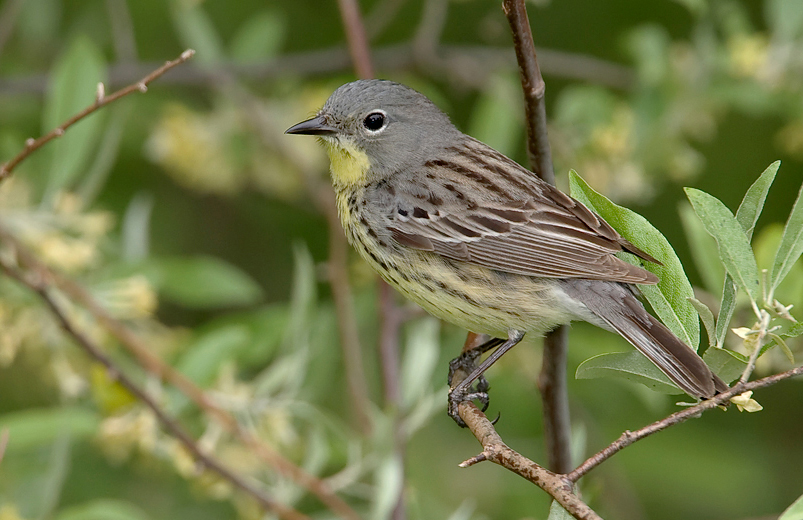 The only other decent shot of this bird that I got. Though I don’t normally chase rare birds, I was glad I came out to shoot this individual, just as I had the individual in 2010. My photos from 2010 were much better than these (far, far better in my opinion), but it was nice to be able to shoot an individual with a different plumage, for comparison. I wouldn’t be surprised if this was indeed a different gender or different age from the 2010 bird. But I’ll leave that for the experts to decide. (Some weeks later a friend would forward me a video from a digiscoper who was also present when we were shooting this bird. For a moment, she also caught my dog in the background hunting bugs in the grass, which was entertaining to see). May 13, 2012 With Migratory Bird Day over, I was hoping the crowds would be thinner, and today they certainly were: there were far fewer people at Magee today than yesterday. Although I enjoy the festive atmosphere of Migratory Bird Day at Magee, the crowds can be very frustrating. It was nice to see all the open spaces when I arrived this morning. I decided to start out in the West Tower because people had been talking about how good it was yesterday. I didn’t have a whole lot of luck there. Around mid-morning the few photographers left the tower. My best shot of the morning was a Prothonotary warbler: 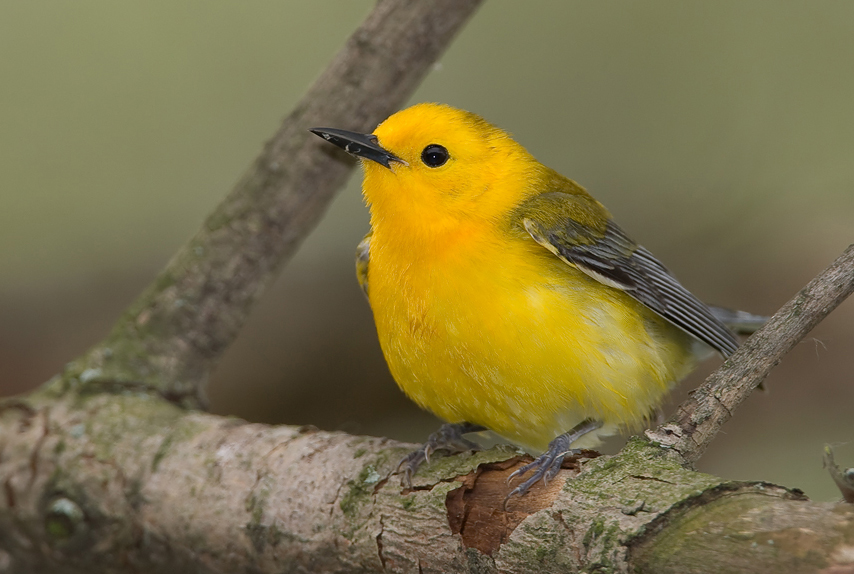 Prothonotary warbler. Though this species is common back home I still photograph them whenever possible at Magee because they’re so pretty. Fortunately, they breed at Magee and aren’t shy. Around noon I decided to try the new West Trail again. Though Ken Kauffman tweeted about a Kirtland’s being sighted there this morning, no-one else seems to have seen it. A birder played its call through a speaker (a practice I do NOT recommend, especially for endangered species) but he was unable to find the bird. His calls did attract a yellow warbler and a chestnut-sided warbler, but no birds wanted to come out into the open. The foliage is simply too thick this year. In the early afternoon a birder named Andy found a screech owl nest on the West Trail:  Screech owl chick peeking out of its nest at me. Don’t worry, I was far away from the nest; my high-powered optics magnify the view and make the bird look close. There are many owl nests at Magee, though I’ve never seen one this close and out in the open like this. Next some friends and I walked the pedestrian road that borders the main parking lot. Some birds were coming out here and there, but we still weren’t get any decent photos, and then the wind died down (when the wind blows from the south the birds often come out to the northern edge of the woods where we can see them). I tried the loop behind the sportman’s bird center, but much of it is closed off due to an eagle nest, and I didn’t see many birds. 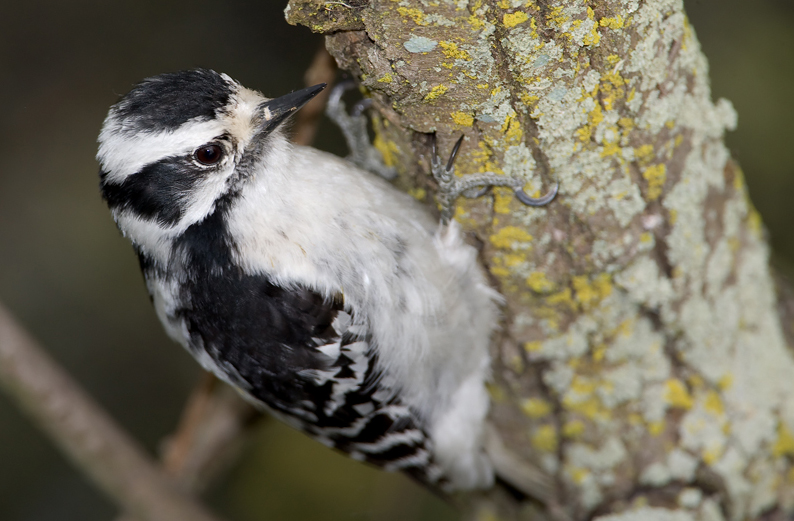 Downy woodpecker that I photographed earlier today. In the late afternoon I suddenly realized that I was exhausted. It was only my sixth day at Magee this year, but twelve-hour days in the field hauling around big, heavy lenses can really wear you down—even if you’re having a lot of fun doing it. But my tiredness combined with the lack of good birding made me think that I should probably head home soon, and save my vacation days for another birding trip. I always try to be flexible when scheduling the dates of my stay at Magee, since you can never know in advance when the good days will be, or whether it might just turn out to be a bad year. I decided to try one of the parks to the west of Magee, called Ottowa National Wildlife Refuge. There’s a lengthy auto tour that you can drive, though I believe it’s only open once a month, and today just happened to be the day it was open (I got lucky for a change). There were many egrets on the tour, and I found a black-crowned night heron preening on a branch right above the road, though for some reason the aesthetics just didn’t work out right for me with that bird. Far more exciting for me was that I found a group of yellow warblers arguing over territory boundaries, and they kept at it for well over an hour. The yellow warbler has been my nemesis bird for as long as I’ve been coming to Magee: they’re everywhere at Magee, but they never give me a chance to get a good photo (unlike the Prothonotaries, who love to pose for the camera). I stalked the birds with my hand-held 500mm f/4 rig, nailing several shots that I knew were keepers. You can see my best shot from that session up at the beginning of this blog; below is my second favorite: 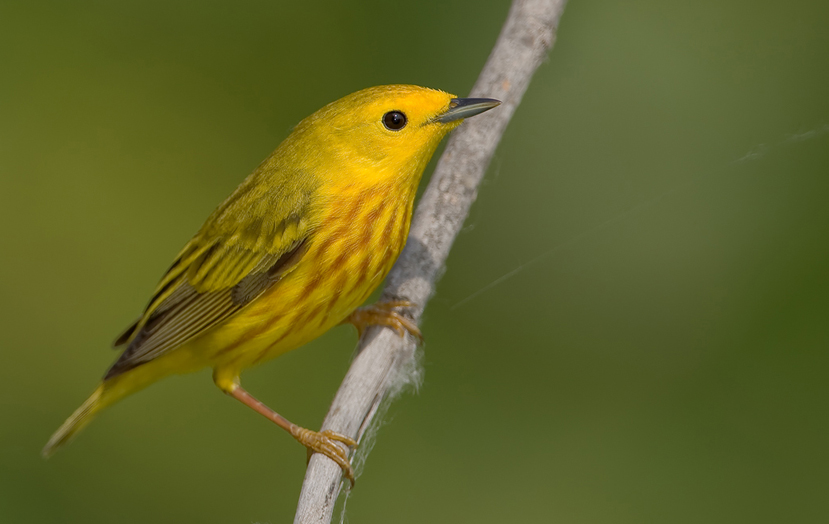 My nemesis bird at Magee: the yellow warbler. At Ottowa (next door to Magee) I finally got a few good shots of them. Of course, I’d still like to get some more. Just as I was finishing with the yellow warblers a photographer friend named Dale found a yellow-headed blackbird at Metzger (another park close to Magee). Several of us tried to relocate the bird but were unsuccessful. Everybody was exhausted and we all decided to call it a day. I’d been thinking that I might make today my last day at Magee for this season, but it’s hard to leave such a wonderful place (even in a bad year), so I decided around 7pm to walk the boardwalk one more time. I saw no birds whatsoever. I decided to head home in the morning. Though it had been one of my worst years at Magee, I was happy just to be here. For me, Magee is one of the happiest places in the world. I have so many fond memories of walking this boardwalk hunting for warblers that it has become like an obsession for me. I can’t wait till next year. May 14 This morning Brandy and I woke up and packed everything into the car, hit the local MacDonalds for our last high-calorie breakfast (photography is taxing work, so I always eat hearty when on a photo trip), and hit the highway.  Unidentified Flying Object at Magee. Bird photographers like to play jokes on each other from time to time. This was one of the more amusing ones, but the full details of that story will have to wait for another time. It took eleven and a half hours to drive back to Durham (North Carolina). I spent much of the drive thinking about my next trip to Magee: what dates I should come, how I might improve my equipment or my technique, etc. Unfortunately, I’m planning to go back to school next year to start working full-time on my PhD, so for the next few years I’ll be living more frugally and will have to limit my birding trips. But hopefully I’ll find a way to reduce my costs and make at least a short trip to my absolute favorite birding location in North America. |
|
See also: my 2013 Magee Marsh trip report All bird photos on this page are licensed under Creative Commons. You may re-use these bird photos for any purpose whatsoever, provided that you give proper and appropriate attribution to me. You can read the fine print here. (The text is copyrighted, however.)  See
many more of
my bird photos at:
 |